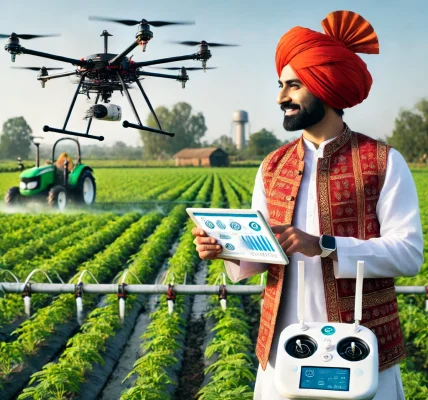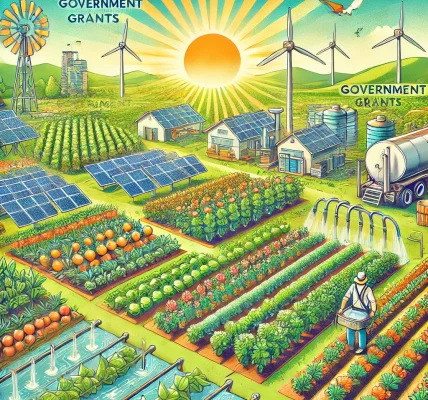Introduction
For farmers in India, securing financial assistance is crucial for sustaining and expanding agricultural activities. The government provides multiple funding options, primarily in the form of loans and grants. However, choosing between them can be challenging. While loans require repayment with interest, grants are essentially free financial assistance with specific eligibility criteria.
In this guide, we will explore the differences between government agricultural loans and grants, their benefits, eligibility criteria, and how farmers can apply for these funding opportunities.
Understanding Loans & Grants in Agriculture
What is a Government Agricultural Loan?
A government-backed agricultural loan is financial assistance provided to farmers, agribusinesses, or cooperatives with an agreement to repay the borrowed amount with interest over a specific period. These loans are designed to support:
- Crop production (seeds, fertilizers, pesticides)
- Farm mechanization (tractors, irrigation systems, storage facilities)
- Livestock and dairy farming
- Agricultural exports and agribusiness expansion
Types of Agricultural Loans in India
- Kisan Credit Card (KCC) Loan
- Short-term credit facility for purchasing seeds, fertilizers, pesticides, etc.
- Interest rates as low as 4% with timely repayment.
- Offered by commercial banks, regional rural banks (RRBs), and cooperative banks.
- Agriculture Term Loan
- Medium to long-term loans for purchasing farm equipment, irrigation systems, and infrastructure.
- Available from NABARD-backed institutions and commercial banks.
- Dairy & Animal Husbandry Loan
- Loan assistance for cattle farming, poultry, and fisheries.
- Subsidies are available under the Animal Husbandry Infrastructure Development Fund.
- Agricultural Infrastructure Loan
- Loans for setting up cold storage, warehouses, food processing units.
- Government support through the Agriculture Infrastructure Fund (AIF).
- Mudra Loan for Agriculture
- Under the Pradhan Mantri Mudra Yojana (PMMY), small farmers and agribusiness owners can access credit up to ₹10 lakh.
What is a Government Agricultural Grant?
A grant is a non-repayable financial aid provided by the government to support agricultural development. Unlike loans, grants do not require repayment but come with specific conditions and eligibility requirements.
Types of Agricultural Grants in India
- Paramparagat Krishi Vikas Yojana (PKVY)
- Grants for promoting organic farming practices.
- ₹50,000 per hectare is provided to farmers.
- Rashtriya Krishi Vikas Yojana (RKVY)
- Financial assistance for innovative agricultural projects.
- Farmers, cooperatives, and FPOs can apply.
- National Food Security Mission (NFSM)
- Grants for pulses, cereals, oilseeds production.
- Special incentives for small and marginal farmers.
- Dairy Entrepreneurship Development Scheme (DEDS)
- 25% to 33% subsidy on dairy farming investments.
- Agro-Processing Cluster Development Grant
- Up to 35% of project cost for setting up food processing units.
Loans vs. Grants: Key Differences
| Feature | Loans | Grants |
|---|---|---|
| Repayment Required | Yes (with interest) | No |
| Source | Banks, NABARD, government schemes | Government ministries, state funds |
| Eligibility | Credit score, collateral (for large loans) | Specific farming projects and initiatives |
| Usage | Flexible (farm inputs, machinery, land, livestock) | Restricted to specific programs (organic farming, food security, etc.) |
| Approval Process | Faster | More scrutiny, eligibility verification |
| Risk Factor | Requires repayment even if the business fails | No financial burden on the farmer |
Which One Should You Choose?
When to Choose a Loan
- If you need large-scale funding for farm expansion or mechanization.
- When immediate access to capital is required.
- If you have a stable income to repay the loan.
- When grant eligibility criteria do not match your farming business needs.
When to Choose a Grant
- If you qualify for specific government schemes.
- When you want financial support without repayment pressure.
- If your farm project aligns with government objectives (organic farming, food processing, dairy farming, etc.).
- When long-term sustainability and risk-free investment are priorities.
How to Apply for Government Agricultural Loans & Grants
Applying for an Agricultural Loan
- Choose the Right Loan Type
Identify whether you need a Kisan Credit Card loan, term loan, infrastructure loan, or a Mudra loan. - Prepare Required Documents
- Aadhaar Card & PAN Card
- Land ownership proof
- Bank account details
- Business plan (for large-scale loans)
- Visit Your Bank
Approach a commercial bank, NABARD-affiliated bank, or cooperative bank. - Apply & Get Loan Approval
Submit the application, and once approved, funds are disbursed to your account.
Applying for an Agricultural Grant
- Find the Right Grant Scheme
- Visit government portals like agricoop.nic.in or pmkisan.gov.in.
- Check Eligibility
- Ensure your farm project meets the government’s criteria.
- Submit Application
- Apply online through the scheme’s portal or visit local agricultural offices.
- Verification & Approval
- Once approved, funds are provided as per the scheme guidelines.
Final Thoughts
Both loans and grants are crucial for agricultural development, but choosing the right one depends on your financial situation and farming goals. If you need quick funding with flexibility, an agricultural loan is ideal. However, if you qualify for a government grant, it can be a risk-free way to fund your farm expansion or modernization.
To maximize benefits, farmers can even combine both options—using grants for specific projects while securing loans for broader investments.




